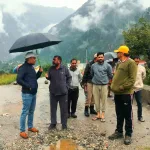India has not declared Operation Sindoor completely over. What exists now is a sensitive halt in operations—some may call it a ceasefire, but military leaders have deliberately avoided that word. From a war fighting perspective, this is not merely a pause; it is a strategic hold following a rare and unambiguous military victory.
After just four days of calibrated military action, it is objectively conclusive: India achieved a massive victory. Operation Sindoor met and exceeded its strategic aims—destroying terrorist infrastructure, demonstrating military superiority, restoring deterrence, and unveiling a new national security doctrine. This was not symbolic force. It was decisive power, clearly applied.
India was attacked. On April 22, 2025, 26 Indian civilians, mostly Hindu tourists, were massacred in Pahalgam, Jammu & Kashmir. The Resistance Front (TRF), an offshoot of the Pakistan-based Lashkar-e-Taiba (LeT), claimed responsibility. As has been the case for decades, the group is backed by Pakistan’s Inter-Services Intelligence (ISI).
But unlike previous attacks, this time India didn’t wait. It didn’t appeal for international mediation or issue a diplomatic demarche. It launched warplanes.
On May 7, India initiated Operation Sindoor, a swift and precisely calibrated military campaign. The Indian Air Force struck nine terrorist infrastructure targets inside Pakistan, including headquarters and operational hubs for Jaish-e-Mohammed and Lashkar-e-Taiba. The message was clear: terror attacks launched from Pakistani soil will now be treated as acts of war.
Prime Minister Narendra Modi made the new doctrine unmistakable: “India will not tolerate any nuclear blackmail. India will strike precisely and decisively at the terrorist hideouts developing under the cover of nuclear blackmail.”
More than a retaliation, this was the unveiling of a strategic doctrine. As Modi said, “Terror and talks can’t go together. Water and blood can’t flow together.”
Operation Sindoor was executed in deliberate phases:
May 7
Nine precision strikes were launched deep into Pakistani territory. Targets included key terror training camps and logistics nodes in Bahawalpur, Muridke, Muzaffarabad, and elsewhere.
May 8
Pakistan retaliated with a massive drone swarm across India’s western states. India’s multi-layered air defense network—domestically built and augmented by Israeli and Russian systems—neutralized nearly all of them.
May 9
India escalated with additional strikes on six Pakistani military airbases and UAV coordination hubs.
May 10:
A temporary halt in firing was reached. India did not call it a ceasefire. The Indian military referred to it as a “stoppage of firing”—a semantic but deliberate choice that reinforced its strategic control of the situation.
This wasn’t just tactical success. It was doctrinal execution under live fire.
Strategic Effects Achieved:
A New Red Line Was Drawn—and Enforced
Terror attacks from Pakistani soil will now be met with military force. That’s not a threat. It’s precedent.
Military Superiority Demonstrated
India showcased its ability to strike any target in Pakistan at will—terror sites, drone coordination hubs, even airbases. Meanwhile, Pakistan was unable to penetrate a single defended area inside India. That is not parity. That is overwhelming superiority. And that is how real deterrence is established.
Restored Deterrence
India retaliated forcefully but stopped short of full war. The controlled escalation sent a clear deterrent signal: India will respond, and it controls the pace.
Asserted Strategic Independence
India handled this crisis without seeking international mediation. It enforced doctrine on sovereign terms, using sovereign means.
Operation Sindoor was not about occupation or regime change. It was limited war executed for specific objectives. Critics who argue India should have gone further miss the point. Strategic success isn’t about the scale of destruction—it’s about achieving the desired political effect.
India was not fighting for vengeance. It was fighting for deterrence. And it worked.
India’s restraint is not weakness—it is maturity. It imposed costs, redefined thresholds, and retained escalation dominance. India didn’t just respond to an attack. It changed the strategic equation.
In an age where many modern wars spiral into open-ended occupations or political confusion, Operation Sindoor stands apart. This was a demonstration of disciplined military strategy: clear goals, aligned ways and means, and adaptive execution in the face of unpredictable escalation. India absorbed a blow, defined its objective, and achieved it—all within a contained timeframe.
The use of force in Operation Sindoor was overwhelming yet controlled—precise, decisive, and without hesitation. That kind of clarity is rare in modern war. In an era defined by “forever wars” and cycles of violence without strategic direction, Sindoor stands apart. It offers a model of limited war with clearly defined ends, matched ways and means, and a state that never relinquished the initiative.
The India of 2008 absorbed attacks and waited. This India hits back—immediately, precisely, and with clarity.
Modi’s doctrine, India’s advancing domestic defense industry, and the professionalism of its armed forces all signal a country no longer preparing for the last war. It is preparing for the next one.
The halt in operations is not the end of Operation Sindoor. It is a pause. India holds the initiative. If provoked again, it will strike again.
This is deterrence restored. This is a new doctrine revealed. And it should be studied by all nations confronting the scourge of state-sponsored terrorism.
Operation Sindoor was a modern war—fought under the shadow of nuclear escalation, with global attention, and within a limited objective framework. And by every measure that matters, it was a strategic success—and a decisive Indian victory.
(The Author is executive director of the Urban Warfare Institute. He is the co-author of Understanding Urban Warfare)








